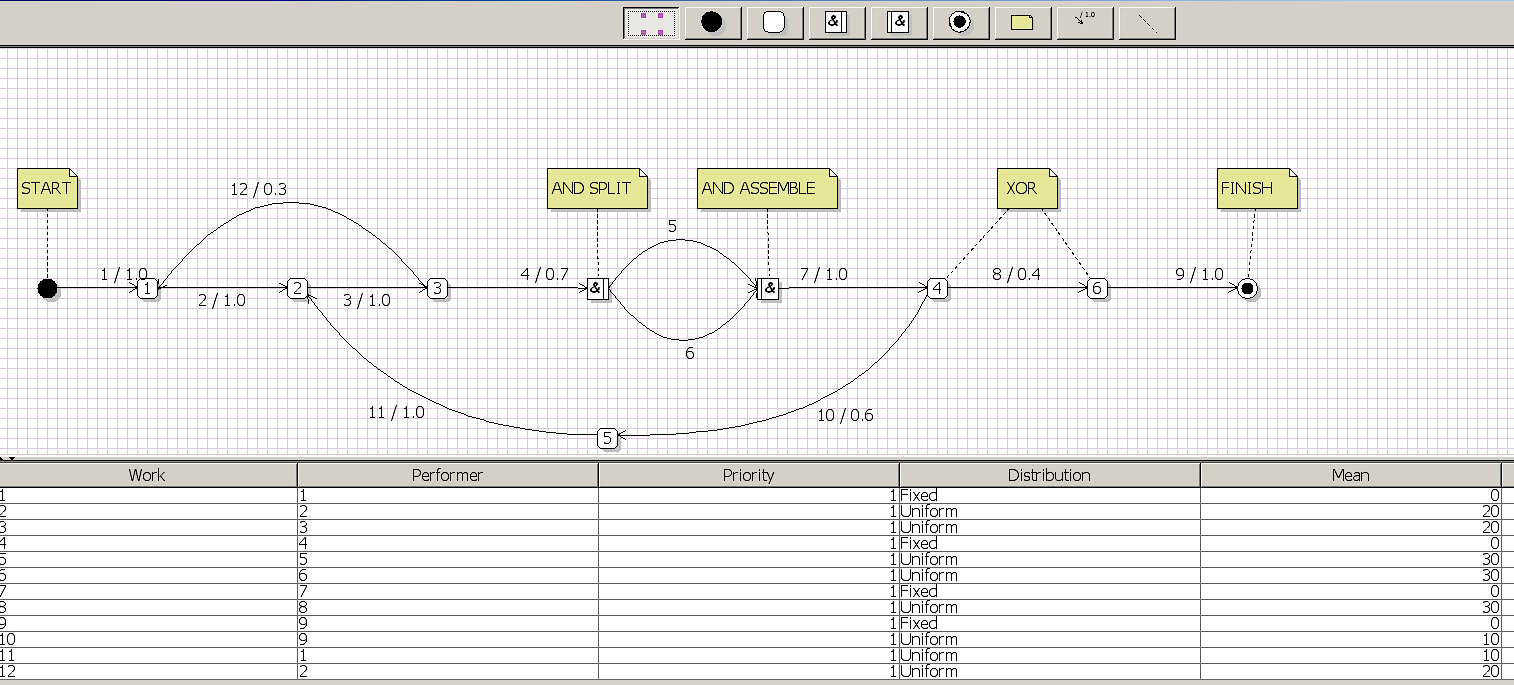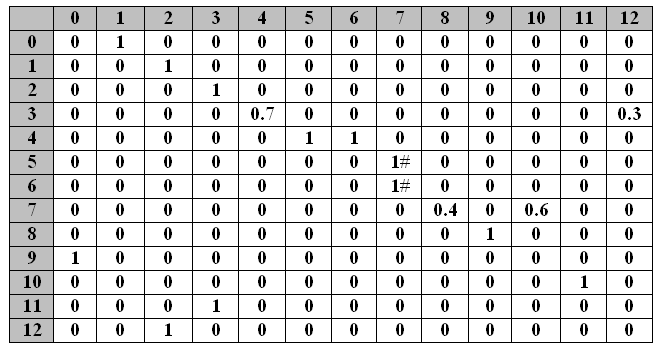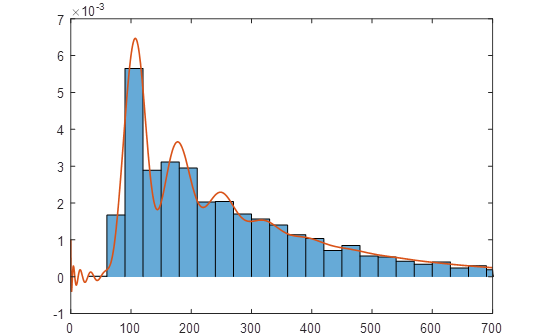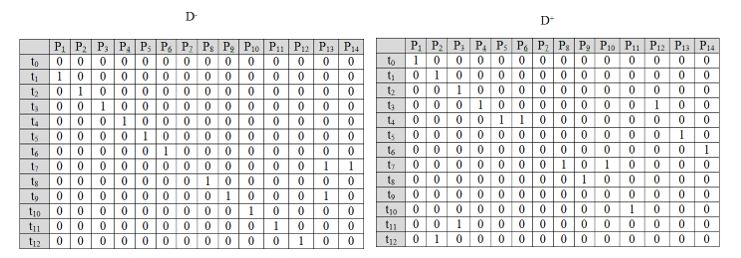Abstract
The task of business processes is important, relevant and occupies a worthy place in the field of business analysis. There is a large number of general purpose simulation systems, equipped with a detailed interface, statistical processing of simulation results and optimization of objects. The wide possibilities of objects of various types provided by such systems are accompanied by considerable difficulties in their mastering by users interested in business process but not being experts in the field of. In addition, manual construction of object simulation models in the environment can be very time-consuming. The article proposes an approach to the construction of a tool that provides automatic generation of executable simulation model of the business process, designed to run in the selected simulation system, but formed outside this environment. Such a tool can be a program-editor of a business process with the function of exporting a mathematical model of a business process to the executable file of its simulation model. The principal aspects of solving this problem in relation to simulation systems based on the formalisms of queuing networks and Petri nets are considered. A description is given of a functioning business process program-editor focused on using the GPSS World simulation system. The results of its application are demonstrated. The conclusion is made about the possibility and expediency of extending the proposed concept to other objects and simulation systems.
Keywords: Business processbusiness processautomated simulation model generating
Introduction
An objective assessment of various indicators of the business process is impossible without simulation. The choice of a business process format precedes the construction of its simulation model.
We will adhere to the following definition: a business process is an ordered set of activities, subordinated to the achievement of a single goal of completing a business process with a given result. Description and documentation of business processes is a necessary stage of implementation and successful functioning of the business process management system of the organization (Lapina et al., 2015; Yakimov, Kirpichnikov, Mokshin, Alyautdinova, & Pajgina, 2015; Zaharov, 2016). The presence of business processes that are properly documented provides a formal transition from a standardized description of the business process to its mathematical model (Artamonov, 2018).
Business analyst has a wide range of simulation systems that provide the construction and conduct experiments with the business process model. The process of building a model in a system environment can be tedious and require certain skills from the user. There is an objective contradiction: on the one hand, a business analyst is interested in obtaining an objective assessment of the time and cost indicators of the business process, and on the other hand, does not have the ability, and sometimes the desire, to master a complex system of simulation, which provides the construction of a simulation model of the business process.
The solution of this contradiction consists in the creation of a software product that provides an automated transition from a formal description of the object of a certain class to its simulation model intended for direct execution in a given simulation environment. This problem can be solved for a number of modern simulation systems (Gradišar & Mušič, 2012; Kanduč & Blaž, 2015).
To do this, certain requirements for the type and structure of the executable file of the simulation model must be met. These requirements, which are further described in the example of various simulation systems, can be defined as follows. The executable file of the simulation model must have the content and structure to be analyzed and decrypted. This condition is met by executable files of a significant number of simulation systems. In some cases, the model file is a text file (GPSS World (Safiullin, Devyatkov, & Zakirova, 2015) or C# file (Mobius (Keefe & Sanders, 2015), quite often it is an xml file (CPN Tools (Boubeta-Puig, Diaz, & Macia, 2019; Jensen & Kristensen, 2009), Anylogic (Nastyuk, Kulikova, Trubina, & Nazarov, 2017). In these and similar cases, the content of the executable file of the model can be analyzed and corrected. Thus, it becomes possible to automatically construct a simulation model intended to be launched in a given simulation environment, but formed outside this environment.
The feasibility of building such a bridge between the formal description of the business process and the modern simulation system is also due to the significant size and complex structure of real business processes.
Problem Statement
The task of building a simulation model of the business process is divided into the following stages.
1. To propose a general mathematical model of the business process, which allows further transition from the initial description of the business process to the format of its representation in a given simulation system.
2. To analyze the simulation systems for the possibility of external formation of the executable file of the model
3. To offer the rule of formation of the executable file of the chosen system of simulation modelling
Research Questions
We will be guided by the proposed model of the business process EXECUTOR in the form of a queuing network. To form an executable file of the simulation model, regardless of the formalism proposed by this modelling environment, it is necessary to solve the following tasks within this formalism.
1. To form the elements of the business process EXECUTOR structure - nodes of a queuing network.
2. To set claim routing between the nodes of a queuing network.
3. To set the duration distribution laws for the claim service in the nodes of a queuing network.
4. To set the parameters of the input claim flow of a queuing network.
5. To form an algorithm for transforming the parameters of the business process EXECUTOR into a formal model used by the selected simulation system. Next, it is necessary to provide an adequate representation of the business process model in the format of the simulation model executable file.
The last problem, the most difficult for any simulation systems is solved in different ways.
Purpose of the Study
The purpose of the study is to prove the feasibility of the proposed approach to business process modelling. For this purpose, analysis of simulation systems is performed for the possibility of external generation of the executable model file. A number of simulation systems based on various formalisms of modelling object representation are considered
Research Methods
Business process formal definition
1. The modern business process description standard BPMN (Yakimov, Kirpichnikov, Mokshin, Alyautdinova, & Pajgina, 2015) basically forms the structure of the business process with the help of task elements and logical functions XOR and AND. Up to the formal image of these elements, the activity set with an arbitrary order of their sequence can be represented by a probabilistic graph, a sample of which is shown on the top of Fig.


GPSS World: How to construct the business process simulation model executable file
The GPSS system is best suited for the queuing networks simulation. For any business process that is represented by a probabilistic graph or a transmission matrix, the GPSS simulation program code can be generated as a custom template consisting of a limited number of segments. Moreover, the text of a significant part of the segments remains unchanged, no matter how the structure and parameters of the business process change. The structure of the template program remains invariant with respect to the quantitative and qualitative parameters of the simulated business process. This is the point of using a single GPSS template for a business process simulation program. The expressive power of the GPSS system allows the routing of claims using a set of FUNCTION commands, each of which practically displays the corresponding row of the transmission matrix

The executable file formation in the environment of modeling systems focused on the use of Petri nets formalism
The number of modeling packages using Petri nets, which are mentioned in various sources, clearly exceeded one hundred. Note also that the idea to use the Petri net formalism for queuing networks modelling is not new (Mutarraf, Barkaoui, Li, Wu & Qu, 2018) and is implemented, in particular, in the QPME package (Queuing Petri net Modelling Environment) (Al-Azzoni, 2017). It is proposed to consider the implementation of the proposed approach in relation to the simulation packages Mobius and CPN Tools, focused on the use of extended Petri nets. The structure of the Petri net is known to be given by a pair of matrices D- and D+ whose strings are the input and output transition functions of the Petri net.
The transmission matrix of queuing network is easily transformed into the mentioned pair of matrices. Figure

The executable file of the CPN Tools simulation model has a cpn extension and is an xml file. The structure of the cpn file is open. The contents of the file can be modified with an external program by modifying, adding, removing lines of code, thereby determining the appropriate changes to the Petri net. Mobius (Keefe & Sanders, 2015) package involves the use of Stochastic Activity Networks formalism, which is an extended Petri nets. The object model in this case consists of three files with different extensions. Two of them are service files that are almost invariant to the content of the simulated object. The third file with the cpp extension is a C# code that is available for analysis and can be generated by an external program. Thus, the Petri net constructed from the initial representation of the probabilistic graph of the business process can be transformed into formalisms used by the CPN Tools and Mobius packages.
The executable file formation in the environment of Anylogic
Anylogic modeling system (Nastyuk et al., 2017) allows user to create simulation models based on several modeling paradigms. To model the business process EXECUTOR, a discrete-event approach to the simulation model construction is implemented (Babkin & Kopica, 2016). The executable file of the model with the extension alp is an xml file with obvious structural content. An Alp file consists of blocks, elements of the object model, placed between the opening and closing tags. The composition of the blocks is determined by the choice of the simulation object and the modeling problem. A process modeling library containing the necessary set of blocks for modeling business processes of the class in question is available in Anylogic. The functionality of the blocks can be extended to the required level if necessary. At the initial stage, a business process template model is formed in the Anylogic environment, which can then be modified by an external program in accordance with the structure and parameters of the business process under study. The possibility of creating an executable simulation model file outside the Anylogic system is confirmed by the analysis of the model construction process — the order of activity specified by the transmission matrix, and the parameters of the business process are obviously formally transformed into the appropriate blocks of the alp file. The experience of other authors in the external formation of the alp file is also positive (Kanduč & Blaž, 2015).
Findings
1. The proposed concept of business process modeling is fundamentally feasible.
2. The proposed concept has been brought to practical implementation in relation to the GPSS World simulation system — the Violet-BP business process model editor has been developed to automatically generate the GPSS program code.
3. The study of a number of modeling systems, namely, CPN Tools, Mobius, Anylogic, based on the use of different formalisms allows us to conclude that this modeling concept is applicable to them
Conclusion
The number of different simulation systems is increasing at high speed. This circumstance is primarily due to the emergence of new objects to be simulated and the need to obtain a tool especially designed for the new object simulation.
An alternative concept is to use well-known and reputed simulation systems together with specially developed software-editors that automatically generate the code of the object simulation program for some class of objects. The proposed concept of business process modeling can be developed in different directions and extended to any modeling objects.
APPENDIX: GPSS MODEL CODE
Generated by Violet-BP 0.1a
alpha EQU 3 ; order of Erlang distribution
GENERATE_TIMING VARIABLE (Exponential(1,0,130000))
T_IME TABLE M1,0,30,40
DISTRIB_Fixed VARIABLE (FN$M_EAN)
DISTRIB_Uniform VARIABLE (Uniform(2,(0.4#FN$M_EAN),(1.6#FN$M_EAN)))
DISTRIB_Exponential VARIABLE (Exponential(1,0,FN$M_EAN))
DISTRIB_Triangular VARIABLE (Triangular(3,(0.4#FN$M_EAN),(1.6#FN$M_EAN),FN$M_EAN))
DISTRIB_Erlang VARIABLE (Gamma(3,0,(FN$M_EAN/alpha),alpha))
; Performers:
; 1 => 1
; 2 => 2
; 3 => 3
; 4 => 4
; 5 => 5
; 6 => 6
; 7 => 7
; 8 => 8
; 9 => 9
;
; Works:
; 1 => 1, 1001
; 2 => 2, 1002
; 3 => 3, 1003
; 4 => 4, 1004
; 7 => 5, 1005
; 8 => 6, 1006
; 9 => 7, 1007
; 10 => 8, 1008
; 11 => 9, 1009
; 12 => 10, 1010
; 5 => 11, 1011 #
; 6 => 12, 1012 #
NODE_NUM FUNCTION P$COLNUM,D12
1,1/2,2/3,3/4,4/5,7/6,8/7,9/8,9/9,1/10,2/11,5/12,6
P_RIORITY FUNCTION P$COLNUM,D12
1,1/2,1/3,1/4,1/5,1/6,1/7,1/8,1/9,1/10,1/11,1/12,1
M_EAN FUNCTION P$COLNUM,D12
1,0.0/2,20.0/3,20.0/4,0.0/5,0.0/6,30.0/7,0.0/8,10.0/9,10.0/10,20.0/11,30.0/12,30.0
D_ISTRIBUTION FUNCTION P$COLNUM,D12
1,0/2,2/3,2/4,0/5,0/6,2/7,0/8,2/9,2/10,2/11,2/12,2
A_DVANCE ADVANCE V$DISTRIB_Fixed
TRANSFER ,R_ELEASE
ADVANCE V$DISTRIB_Uniform
TRANSFER ,R_ELEASE
; Transfer matrix:
GRID EQU 10
MAXCOLNUM EQU 12
LINE_0 FUNCTION RN1,D13 ; generate
0.0,0/1.0,1/1.0,2/1.0,3/1.0,4/1.0,5/1.0,6/1.0,7/1.0,8/1.0,9/1.0,10/1.0,11/1.0,12
LINE_1 FUNCTION RN1,D13 ; 1
0.0,0/0.0,1/1.0,2/1.0,3/1.0,4/1.0,5/1.0,6/1.0,7/1.0,8/1.0,9/1.0,10/1.0,11/1.0,12
LINE_2 FUNCTION RN1,D13 ; 2
0.0,0/0.0,1/0.0,2/1.0,3/1.0,4/1.0,5/1.0,6/1.0,7/1.0,8/1.0,9/1.0,10/1.0,11/1.0,12
LINE_3 FUNCTION RN1,D13 ; 3
0.0,0/0.0,1/0.0,2/0.0,3/0.7,4/0.7,5/0.7,6/0.7,7/0.7,8/0.7,9/1.0,10/1.0,11/1.0,12
LINE_4 FUNCTION RN1,D13 ; 4
0.0,0/0.0,1/0.0,2/0.0,3/0.0,4/0.0,5/0.0,6/0.0,7/0.0,8/0.0,9/0.0,10/0.0,11/1.0,155 ; ->11 ->12
LINE_5 FUNCTION RN1,D13 ; 7
0.0,0/0.0,1/0.0,2/0.0,3/0.0,4/0.0,5/0.4,6/0.4,7/1.0,8/1.0,9/1.0,10/1.0,11/1.0,12
LINE_6 FUNCTION RN1,D13 ; 8
0.0,0/0.0,1/0.0,2/0.0,3/0.0,4/0.0,5/0.0,6/1.0,7/1.0,8/1.0,9/1.0,10/1.0,11/1.0,12
LINE_7 FUNCTION RN1,D13 ; 9
1.0,0/1.0,1/1.0,2/1.0,3/1.0,4/1.0,5/1.0,6/1.0,7/1.0,8/1.0,9/1.0,10/1.0,11/1.0,12
LINE_8 FUNCTION RN1,D13 ; 10
0.0,0/0.0,1/0.0,2/0.0,3/0.0,4/0.0,5/0.0,6/0.0,7/0.0,8/1.0,9/1.0,10/1.0,11/1.0,12
LINE_9 FUNCTION RN1,D13 ; 11
0.0,0/0.0,1/0.0,2/1.0,3/1.0,4/1.0,5/1.0,6/1.0,7/1.0,8/1.0,9/1.0,10/1.0,11/1.0,12
LINE_10 FUNCTION RN1,D13 ; 12
0.0,0/0.0,1/1.0,2/1.0,3/1.0,4/1.0,5/1.0,6/1.0,7/1.0,8/1.0,9/1.0,10/1.0,11/1.0,12
LINE_11 FUNCTION RN1,D13 ; 5
0.0,0/0.0,1/0.0,2/0.0,3/0.0,4/1.0,5/1.0,6/1.0,7/1.0,8/1.0,9/1.0,10/1.0,11/1.0,12
LINE_12 FUNCTION RN1,D13 ; 6
0.0,0/0.0,1/0.0,2/0.0,3/0.0,4/1.0,5/1.0,6/1.0,7/1.0,8/1.0,9/1.0,10/1.0,11/1.0,12
ASSMB_OFF FUNCTION P$COLNUM,D3
10,1/11,0/12,0
A_SSEMBLE ASSEMBLE 2
TRANSFER ,M_OVE
GENERATE V$GENERATE_TIMING
ROW_0 ASSIGN COLNUM,FN$LINE_0
TRANSFER ,SERV
ROW_1 ASSIGN COLNUM,FN$LINE_1
TRANSFER ,SERV
ROW_2 ASSIGN COLNUM,FN$LINE_2
TRANSFER ,SERV
ROW_3 ASSIGN COLNUM,FN$LINE_3
TRANSFER ,SERV
ROW_4 ASSIGN COLNUM,FN$LINE_4
TRANSFER ,SERV
ROW_5 ASSIGN COLNUM,FN$LINE_5
TRANSFER ,SERV
ROW_6 ASSIGN COLNUM,FN$LINE_6
TRANSFER ,SERV
ROW_7 ASSIGN COLNUM,FN$LINE_7
TRANSFER ,SERV
ROW_8 ASSIGN COLNUM,FN$LINE_8
TRANSFER ,SERV
ROW_9 ASSIGN COLNUM,FN$LINE_9
TRANSFER ,SERV
ROW_10 ASSIGN COLNUM,FN$LINE_10
TRANSFER ,SERV
ROW_11 ASSIGN COLNUM,FN$LINE_11
TRANSFER ,SERV
ROW_12 ASSIGN COLNUM,FN$LINE_12
TRANSFER ,SERV
SERV TEST NE P$COLNUM,0,FIN
TEST G P$COLNUM,MAXCOLNUM,S_TART
S_PLIT SAVEVALUE COLNUM_1,((P$COLNUM-P$COLNUM@(MAXCOLNUM+1))/(MAXCOLNUM+1))
SAVEVALUE COLNUM_2,(P$COLNUM@(MAXCOLNUM+1))
SPLIT 1,CHILD
ASSIGN COLNUM,X$COLNUM_1
TRANSFER ,S_TART
CHILD ASSIGN COLNUM,X$COLNUM_2
TRANSFER ,S_TART
S_TART PRIORITY FN$P_RIORITY
QUEUE (P$COLNUM+1000)
QUEUE P$COLNUM
SEIZE FN$NODE_NUM
DEPART P$COLNUM
TRANSFER FN,D_ISTRIBUTION,A_DVANCE
R_ELEASE RELEASE FN$NODE_NUM
DEPART (P$COLNUM+1000)
TEST GE P$COLNUM,GRID,M_OVE
TRANSFER FN,ASSMB_OFF,A_SSEMBLE
M_OVE SAVEVALUE ROOTER,(P$COLNUM#2)
ASSIGN ROOTER,X$ROOTER
TRANSFER P,ROOTER,ROW_0
FIN TABULATE T_IME
References
- Al-Azzoni, I. (2017). ATL Transformation of Queueing Networks to Queueing Petri Nets. In L. F. Pires, S. Hammoudi and B. Selic (Eds), Proceedings of the 5th International Conference on Model-Driven Engineering and Software Development (MODELSWARD 2017) (pp. 261-268), Porto, Portugal: Scitepress.
- Artamonov, I. V. (2018). Osobennosti primeneniya algoritmicheskogo podhoda k modelirovaniyu biznes-processov [Features of application of the algorithmic approach to modelling business processes]. Vestnik Altajskoj akademii ekonomiki i prava, 2, 5-11. [in Rus].
- Babkin, Е. A., & Kopica, Е. V. (2016). O metodologii imitacionnogo modelirovaniya biznes-processov na osnove agentnogo I diskretno-sobytijnogo podhodov [On the methodology of simulation modeling of business processes bazed on agent-bazed and discrete-event approaches]. Auditorium, 2(10). 72-77. [in Rus]
- Boubeta-Puig, J., Diaz, G., & Macia, H. (2019). MEdit4CEP-CPN: An approach for complex event processing modeling by prioritized colored petri nets. Information systems, 81, 267-289.
- Gradišar, D., & Mušič, G. (2012). Automated Petri-Net Modelling for Batch Production Scheduling. In P. Pawlewski (Ed.) Petri Nets. Manufacturing and Computer Science (pp. 3-26). London; InTech.
- Jensen, K., & Kristensen, M. (2009). Colored Petri Nets. Modelling and Validation of Concurrent Systems. Berlin: Springer-Verlag Berlin Heidelberg. doi:
- Kanduč, T., & Blaž, R. (2015). Automated simulation model building for a complex furniture manufacturing process. Retrieved from https://www.researchgate.net/publication/303425362_ Manufacturing_processes_optimisation_in_a_furniture_factory
- Keefe, K., & Sanders, W. H. (2015). Reliability Analysis with Dynamic Reliability Block Diagrams in the Möbius Modeling Tool. In W. Knottenbelt, K. Wolter, A. Busic, M. Gribaudo & P. Reinecke (Eds.), Proceedings of the 9th EAI International Conference on Performance Evaluation Methodologies and Tools (VALUETOOLS), (pp. 164-170). Berlin, Germany: ICST.
- Lapina, L. A., Stupina, A. A., Kiryakova, O. V., Kapustina, S. V., Voloshin, R. V., & Gron', D. N. (2015). O podhodah k vyboru instrumentariya modelirivaniya biznes-processov [Aproaches to the selection of tools for business process modelling]. Sovremennye problemy nauki i obrazovaniya, 2(2), 57. [in Rus].
- Mutarraf, U., Barkaoui, K., Li, Z., Wu, N., & Qu, T. (2018). Transformation of Business Process Model and Notation models onto Petri nets and their analysis. Advances in mechanical engineering, 10(12), 168781401880817. https://doi.org/10.1177/1687814018808170
- Nastyuk, A. V., Kulikova, Е. S., Trubina, G. F., & Nazarov, A. D. (2017). Anylogic kak instrument imitacionnogo modelirovaniya biznes-processov kompanii [Anylogic as simulation tool the business processes of the company] Moskovskij ekonomicheskij zhurnal, 3, 10. [in Rus].
- Safiullin, A. R., Devyatkov, T. V., & Zakirova, E. A. (2015). Podhod k razrabotke effectivnoj sistemy obsluzhivaniya na osnove modelirovaniya biznes-processov [The approach to developing an effective service system based on simulation modeling of business processes]. Kazanskij ekonomicheskij vestnik. 6(20), 94-101. [In Rus].
- Sidnev, A. (2016). The essence of the mathematical business process models discipline for computer science students. In L. G. Chova, Al. Martinez & I. C. Torres (Eds), ICERI2016 Proceedings (pp. 8236-8242). Seville, Spain: IATED. doi:
- YAkimov, I. M., Kirpichnikov, A. P., Mokshin, V. V., Alyautdinova, G. R., & Pajgina, L. R. (2015). Imitacionnoe modelirovanie biznes-processov v sisteme Bizagi Modeler [Simulation modelling of business processes in Bizagi Modeler]. Vestnik Tekhnologicheskogo universiteta, 18(9), 236-239. [in Rus].
- Zaharov, V. N. (2016). Insrtumenty modelirovaiya biznes-processov [Business process modelling tools]. Vestnik Moskovskogo gosudarstvennogo oblastnogo universiteta. Seriya: Ekonomika, 3, 48-53. [in Rus].
Copyright information

This work is licensed under a Creative Commons Attribution-NonCommercial-NoDerivatives 4.0 International License.
About this article
Publication Date
02 December 2019
Article Doi
eBook ISBN
978-1-80296-072-3
Publisher
Future Academy
Volume
73
Print ISBN (optional)
-
Edition Number
1st Edition
Pages
1-986
Subjects
Communication, education, educational equipment, educational technology, computer-aided learning (CAL), Study skills, learning skills, ICT
Cite this article as:
Aleksandr, S. (2019). Yet Another Business Process Modeling Concept. In N. I. Almazova, A. V. Rubtsova, & D. S. Bylieva (Eds.), Professional Сulture of the Specialist of the Future, vol 73. European Proceedings of Social and Behavioural Sciences (pp. 390-400). Future Academy. https://doi.org/10.15405/epsbs.2019.12.42
